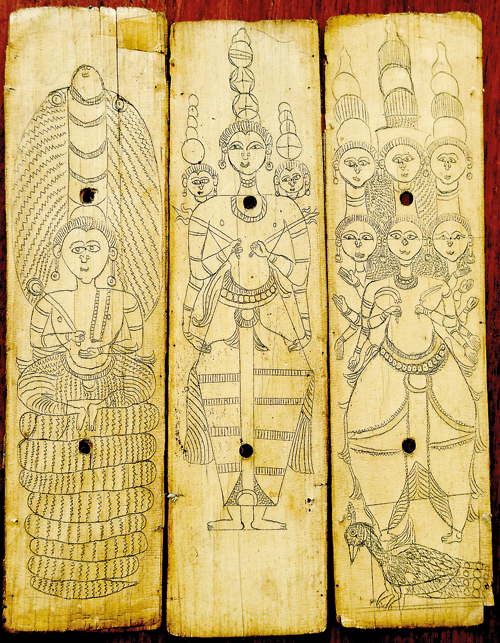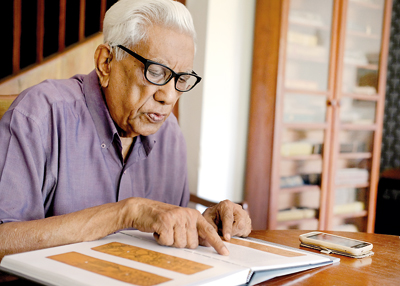Drawn to a hidden world of spirits

Yantras featuring deities, manifesting a convergence of religion and cults
Young L.S.D. Pieris used to be dispatched to a Buddhist temple in Moratuwa to learn his Sinhala, a subject eschewed by the prestigious Anglican school syllabuses of the time. It was in the precincts of the temple that the ten-year-old’s imagination was hooked by his first glimpse of yantra drawings sketched on palm leaf.
This was a world whose memory of the Victorian period was still fresh, and the popular idea of ‘art’ would have been defined by paintings like Landseer’s Monarch of the Glen, reigning over the living rooms. So the yellow ola manuscripts incised with deities, demons and spirit beings, and the curvy Sinhala calligraphy crawling on their edges, intrigued the boy completely.
The very native beauty of the art was beguiling. No part of young Pieris’s world at the time was untainted by European influence. Even murals on temple walls had Dutch and Portuguese embellishments. But now here was art that was purely indigenous: a palimpsest of very ancient cult beliefs- much of which pre-dated Buddhism and offered glimpses to a lost past of spirit cults.
This however seemed only the tip of the iceberg- a peek merely at an unbelievably rich native culture and mythology which he had not known existed. He was fixated by the drawings of the nagas or snake-people, the demons who took many forms, the fearsome Badra-kali and the whole world of dark sorcery and benevolent magic, and it was to become a lifetime’s passion, culminating, this year, in Yantra Drawings on Palm Leaf- Sri Lanka, a splendid volume published by the National Trust Sri Lanka.
Over the years, Mr. Pieris gathered hundreds of manuscripts- his main interest being those dealing with yantras, but also medicine, which too incorporated some magic. Former ritualists would yield inherited manuscripts to him, or he would hunt them down in small shops in Kandy now long gone. He also visited the British Museum to peruse their invaluable collection, and when in the Netherlands traced manuscripts plundered by the Dutch.
The tradition of yantras was very much hidden, as it never formed part of orthodox Buddhism and families of practitioners and artists held the drawings closely. In order to unlock the esoteric world coded in these strips of talipot palm leaf, Mr. Pieris had to read works on astronomy, Buddhism, anthropology, history, archaeology and art history, all of which converge in his study. But his interest in the yantras was mainly as a collector of art, and it was their aesthetic value that always inspired him.
For him, the anthropologist’s sober, scientific, academic accounts of our ancient spirit cults, however erudite, are lifeless. Only a poet can truly envision the fear and respect the spirits- lurking in the landscape- evoked in our village societies, and only a poet may be able to capture that world. Yet the drawings in the book transmit much of that poetry. They are to be treasured because they may be the only window to a world of otherwise completely forgotten lore, not having been altered over the ages so as to retain their potency for magical purposes.
Getting to the ‘nuts and bolts’ of magic, the purpose of these yantra drawings were as archetypes for ritual practitioners: i.e. the exorcists; the kattandiralas or charmers; the kapuralas or mediators at shrines to deities; and the bali eduras or pacifiers of planetary gods and demons. The manuscript books containing these drawings are taken to the place where the ritual is performed. The image is then faithfully reproduced on the ground, or the surface of a plantain or habarala leaf or even on a mat used for sleeping.
These yantras are activated using mantras or incantations. They are used for protective and curative purposes, for soliciting favours, and in rituals and revenge. Sri Lankan yantras fall into three categories: those depicting deities, demons and spirit beings; those with geometrical drawings (mostly symbolic representations of the universe); and those where deities or geometrical drawings are inscribed on metal sheets or painted on paper. The yantras invoke a spirit to satisfy human needs- and there is no supplication or prayer.
Our local yantras still bear traces of Indian origins, but these sub continental cultural elements have all been subjected to adaptation and reinterpretation. One can, for example, easily discern the influence of the curves of the Sinhala script on the drawings.
As the first work on Sri Lankan yantra drawings, this book is a superb evocation of this little-known occult world in all its aspects and dimensions. Apart from his study of ola manuscripts, Mr. Pieris had to refer to many works. As most students of Sri Lankan anthropology and mythology, he was helped by the hefty volumes of Sinhala Verse that the Victorian antiquarian Hugh Nevill so laudably saved from oblivion in his fin-de-siècle.
One of the most fascinating aspects recorded here is how the Sinhalese Buddhist cultural experience absorbed many other religious and cultural strands within its ambit: pre-Buddhist spirit cults, ideas relating to yaksha and naga mythology, and vedda beliefs. There are, also, the weight of Vedic and Brahmanic concepts, and traditions associated with the three main schools of Buddhism: Theravada, Mahayana and Tantrayana.
The book also has added chapters on ‘Chakra Drawings in Astrology’, ‘Yantras Dealing with Maladies of Women and Children’ and ‘Episodes from the Life of the Buddha’ and ‘Stories from the Jataka Tales’- for the reason that they too have functioned as yantras, being used for worldly purposes to satisfy material needs including security, wealth, good health and good fortune.
The book draws to a close with this observation that is beautifully poetic:
“(These) drawings constitute a unique tradition. They are a confession of the frailty of the human condition, and at the same time, evidence of the readiness for self-preservation. They are a testament of long-held beliefs, and like all ritual art, represent human yearning for the transcendent.”
With belief in the yantras and the world they represent giving way rapidly, we are losing much more than a native tradition of art: we will be deprived of rituals that in many village communities “sublimated tensions and fostered harmony, giving cohesion to a society with common bonds of tradition, religion, and culture”- which was, to put it in other words, their “real magic”.
In turning out this invaluable work, L. S. D. Pieris was much encouraged by Dr. Roland Silva, founder president of the National Trust. He urged the author to channel what was a private hobby and passion into the public domain, inviting him to do the first lecture of the Trust and then encouraging him to write on the subject. Mr. Pieris also recalls the help extended by the Gunaratne Offset Pvt. Ltd.
Yantra Drawings on Palm Leaf- Sri Lanka is the fourth publication of a series by the Intangible Heritage Committee of the National Trust.
| Yantra drawings  A lifelong passion and eventually a book: Mr. Pieris points to a section in ‘Yantra Drawings on Palm Leaf- Sri Lanka’. Pix by Amila Gamage “Yantra” is Sanskrit for ‘instrument’ or ‘machine’, and its meaning is contextual. In the ritual arts, as in the major part of the book, it is a visual mantra and an emblem of psychic power, activated by a verbal mantra for a wide range of uses by ritual practitioners. In astrology, it is a device known as the chakra, an astronomical code charting the impact of celestial movements on terrestrial life and the natural world.
| |


